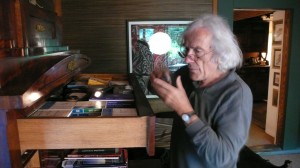List of Films
Abstrakt Nr. 1, Guido und Eva Haas, CH 1958, vernichtet
Abstrakt Nr. 2, Guido und Eva Haas, CH 1958, vernichtet
Declinations I, Guido und Eva Haas, CH 1959, vernichtet
Carceri, Guido Haas, CH 1959/60, vernichtet, Material seit 2012 “in Bearbeitung” für einen Neuschnitt
Declinations II, Guido Haas, 1960, vernichtet
Fabula, Guido Haas, CH 1962, vernichtet
Inclinations I, Guido und Eva Haas, CH 1962/63, 16mm, ca. 6 Min.
Inclinations II, Guido und Eva Haas, CH 1964, 6 Min.
Ruptures, Guido Haas, CH 1965/66, vernichtet
Anamorphosis, Guido Haas, CH 1967, 16mm, 6 Min.
Bio
Eva Haas, *1933; † 1998
Guido Haas, *1931, Bern; ; † 19.8.2020
Nach einer Ausbildung an den Kunstgewerbeschulen in Biel und Zürich, studierte Guido Haas 1951 ein Jahr bei Fernand Léger in Paris. Ab 1958 produzierte er auch experimentelle Filme, viele davon gemeinsam mit seiner Ehefrau Eva Haas. Guido Haas lebt in Kaltacker bei Bremgarten.
Articles about (and from) the Author and his Work
Portrait von Guido Haas in der Schweizer Illustrierten, 1968 Haas_Guido_SI_6.5.68
Portrait des Sohnes Gorgon Haas: Aus der Werkstatt der Schweizer Cineasten Animationsfilm_RadioUndFernsehen_1971
Radio und Fernsehen Nr. 35 29. August bis 4. September 1971
Div. Materialien zu Guido Haas (Künstlerportraits, Kurzgeschichte) Materalien_Guido_Haas
Haas_SpielfilmExposee_ArchivHaas
Haas_Vortrag_InclinationsAnamorphosis ZentralstelleLehrerfortbildung_Ank_Trickfilmkurse_Haas
Screenings (Places and Dates)
Exprmntl 63/64 and 67/67 (Exerpts from the catalogues 63/64 and 67/68)
Solothurner Filmtage 1968 Guido_Haas_Solothurn
 Information über ein Filmprogramm im Théâtre de Poche in Biel am 19.9.69
Information über ein Filmprogramm im Théâtre de Poche in Biel am 19.9.69
Awards and residencies
51/52, 58, 59 und 61 bekam Guido Haas das Eidgenössische Kunststipendium
Miscellaneous
Interview von Thomas Schärer und Fred Truniger. Kaltacker, March 17, 2013. Transcript here: 130417_Haas_Guido_Interview_def
Stills aus seinen Filmen und Fotografien an der Expo 1964 Lausanne (Scans aus verschiedenen, teilweise unidentifizierten Quellen, u.a. Offizieller Führer der Expo 1964, Serielle Manifeste) Guido_Haas_Expo64
Serielle Manifeste, Manifest X: Guido Haas. Informationen über die Arbeitsweise von G+E Haas und Hinweis auf ein Wandbild (14.08m x 2.4m) in derselben Technik, das für die Expo 1964 ausgeführt wurde. Haas_serielle_manifeste_X_StGallen_1966
Dokumentation eines Kunst am Bau-Projektes (http://www.schloss-muenchenwiler.ch/fileadmin/user_upload/pdfs/kunstambau-guidohaas.pdf): kunstambau-guidohaas

Materials from the Archive of the Cinemathèque Belge:
EXPRMNTL69_Haas_BriefAnLedoux_690529
Guido Haas: A short filmic portrait
The painter and filmmaker Guido Haas was one of the first genuine avant-garde filmmakers in Switzerland. Born in 1931, he attended art classes in Biel and Zurich and went to Paris in 1951. There he became a student in Fernand Léger’s atelier. After painting he began – together with his wife Eva Haas – to experiment with film and to scratch directly onto the celluloid. Their second work Inclinations was shown in 1963/64 in the third avant-garde-film festival Exprmntl in Knokke (Belgium). His whole family – his wife Eva and his sons Gorgon and Rhaban – were making films in the late 1960s and early 1970s. Haas abandoned filmmaking, but still paints and has also published poetry. We met him in April 2013 in his house in the remote Fuchsloch (Foxhole) in Emmental (Switzerland).
What we learn out of this filmic note is the tremendous importance of materiality and hand(craft) for the work of Guido Haas. He looks at the 16mm-filmstrips and asks himself how and with what tool they have achieved the scratches. While examining the film and single frames, we are guessing if they had used a razor blade, nails or a comb. Later in the conversation Haas remembers clearly that they used a hammer after he destabilized the celluloid by salt acid, water or heat by a hair-dryer to achieve the “fantastic microstructures” in inclinations. He used different pressures of the hammer in scratching over the film und ripping layers (Filmschicht). How exactly and why these microstructures exactly originated remained a mystery even to Haas. He once wanted to talk about it with a chemist about it. But the fascination about the artistic power of this “absurd primitive way” to produce complex visual structures prevailed his scientific curiosity. However, looking and touching the material – the praxis based research – facilitated or enabled talking and thinking and stimulated his memory. /ts